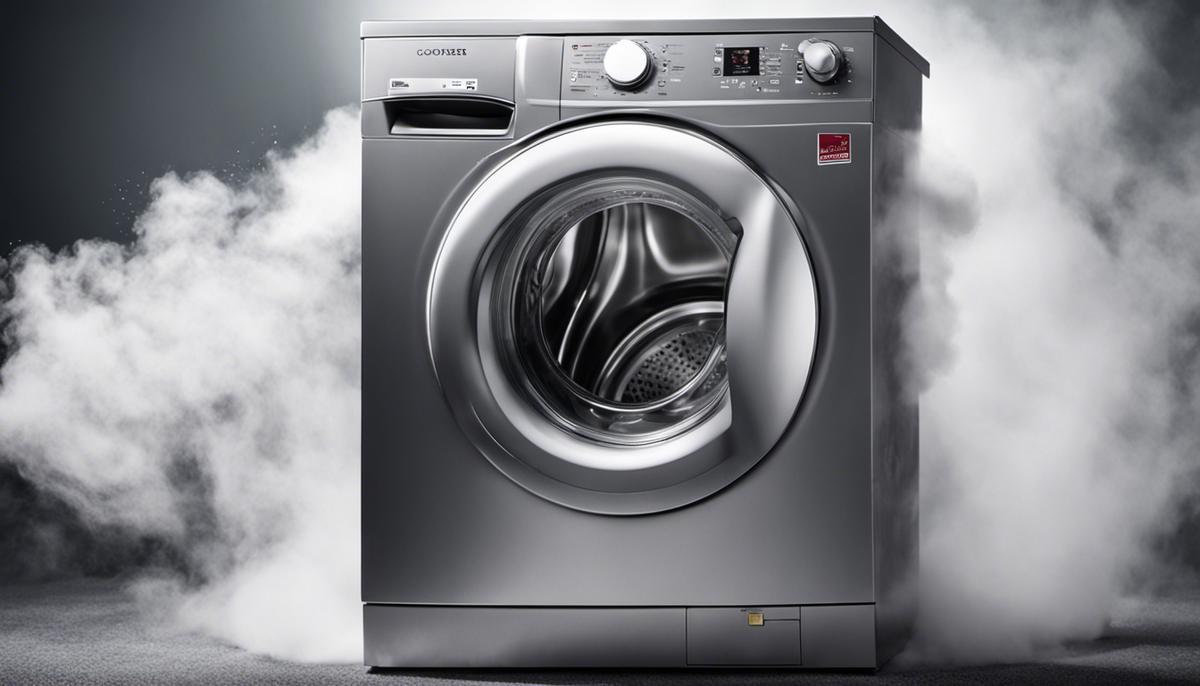Eliminate Odor in Top-Loader Washing Machines
Discovering an unpleasant odor emanating from a top-loader washing machine can be a jarring experience, especially when the machine’s primary role is to clean and freshen our fabrics. The causes of these odors may vary, originating from minor issues like detergent residues to more severe problems like bacterial growth or mold. This necessitates varying cleaning intensities, from quick cleanup operations to extensive deep cleaning tasks. Equally as important is understanding how to properly clean a washing machine, as utilizing ineffective or harmful methods could lead to heightened problems. Therefore, an awareness of effective cleaning agents and processes, including the potential benefits of common household items or dedicated washing machine cleaners, can serve as an extremely valuable tool.
Identifying the Source of the Smell
Unraveling the Mystery: Understanding Unpleasant Smells in Your Top-Loader Washing Machine
Ever dealt with the unpleasant surprise of a foul stench wafting from your top-loader washing machine? Don’t worry. You’re not alone. Many households experience this issue and often overlook the simple reasons behind it. Also, just remember, it doesn’t mean you’re falling short in your homemaking efforts.
Let’s delve into some of the common causes of foul odors in your washing machine and how to freshen things up in no time.
- Build-up of Detergent and Fabric Softener: It might sound counterintuitive, but these cleaning aids can cause smelly problems. When used excessively, detergent and fabric softener residues can accumulate over the drum’s surface, creating an environment for bacteria and mold to thrive. The good news? Running an empty cycle with hot water and two cups of white vinegar can work wonders in scouring away this build-up.
- Blocked or Dirt-filled Drain Pipes: Drain pipes carry the dirty water away after a wash. If they are partially clogged or filled with dirt, the rancid smell could be coming back into the machine and permeating the drum. Detach and rinse out your pipes, or call a professional if necessary, to ensure clear and clean passages for water.
- Laundry Left Behind: Let’s admit it, we’ve all left a wet load in the washing machine longer than intended. Even a few forgotten hours can cause musty smells and mold growth. Act promptly to avoid this – get that fresh laundry out of the machine as soon as the cycle finishes.
- Dirty or Damp Gaskets and Seals: Your machine’s gaskets and seals are more prone to becoming dank and dirty than you might think. Regularly inspecting and cleaning these areas can prevent the growth of mildew, which can contribute to a bad smell.
- Stagnant Water Under the Drum: Water can sometimes pool under the drum due to design quirks or drainage issues. If left untreated, this stagnant water can lead to mildew and unpleasant odors. Professional cleaning or maintenance is typically the best bet if you suspect this is the problem.
Remember, prevention is always better than cure! Regular cleaning and maintenance of your washing machine will ensure a fresh-smelling, efficient machine ready for any laundry challenges that life throws your way! Happy Homemaking!

Cleaning the Washing Machine
Banishing Unpleasant Odors from Your Top-Loader Washing Machine – A Comprehensive Guide
Proudly embracing domestic life and managing a bustling home entails taking care of everyone and everything, including our beloved appliances. Yes! Time to focus a bit on our hardworking top-loader washing machines. The persistent odor troubling your laundry routine may not be just about detergent build-up or blocked drain pipes; there’s more to delve into!
Stealing the spotlight today is that mysterious smell creeping out from your top-loader washing machine. Disconcerting, right? But worry not, dear friend, we’ll wrestle down this challenge together with some tried and true cleaning techniques.
The Hidden Fibers:
Unconsciously, loose fibers from our clothes regularly escape, finding refuge in our washing machines. These fibers, over time, can collectively foster such a vexing scent. Make it a regular practice to wipe across the inner edges of the drum after each load to free lurking fibers. Equipping yourself with an old toothbrush can prove useful in dislodging stuck fabric.
Filter Grime:
Often overlooked, the filter works diligently to strain out bits from our laundry. Forgetting to clean it might leave you with an unpleasant smell. Usually nestled at the machine’s bottom, the filter, when opened, might surprise you with treasure troves of lint, coins, or buttons. Clean it out every one to two months, ensuring no build-up leads to fragrance woes.
Mysterious Mold:
The humid interior of a washing machine can be a promising paradise for mold and mildew. Notably detectable on the rubber lining around the edge of the machine, these unwanted guests can cause a musty smell. Give the rubber lining a thorough cleaning with a mixture of vinegar and warm water using a clean cloth.
Dusty Dispenser Drawers:
Lo and behold, here is another often forsaken place – the dispenser drawer! Residues from detergent and softeners linger here, creating a mix comprising a most dreadful odor. Slide the dispenser out and immerse it in warm soapy water for a few good minutes before scrubbing it clean.
Regular Maintenance:
The key to an odor-free washing machine is regularity. Each month, run a maintenance wash cycle. Set your washer to the highest temperature setting and load it with two cups of white vinegar or a washing machine cleaner. This will banish any stubborn smells and leave your machine squeaky clean and odor-free.
And there you have it. Using these straightforward cleaning tips will help you maintain your washer’s fresh smell and overall performance. Remember, our appliances deserve as much care as they routinely serve us. Here’s to flourishing, fresh-smelling, laundry-doing days ahead!

Odor Prevention Measures
Title: Keeping Your Top-Loader Washing Machine Fresh as a Daisy
After a long day of outdoor play, your kiddos may come home a little muddy, making your trusty top-loader washing machine a beloved household hero. Nevertheless, even this superhero can be susceptible to unpleasant odors which can affect its efficiency as well. You’re already well versed with the common culprits such as the build-up of detergent, dirt-filled drain pipes, and the lurking mold, among other things. Let’s delve into some more measures to prevent these hard-to-shake-off odors in your washing machine.
Properly Dose Your Detergent: As a rule of thumb, always follow the manufacturer’s instructions on the detergent package. Overloading the detergent compartment leads to inadequate rinsing and subsequent residue build-up, which eventually causes an unpleasant smell. Being judicious with your detergent dose can go a long way in avoiding unwelcome washing machine odors.
Use a Machine Cleaning Product: Several market products are specifically designed to clean washing machines. These cleaners tackle odor-causing residues effectively. They can be used every thirty to forty loads to ensure your machine remains as fresh as the clothes it spins.
Ventilation Is Key: Keep the top lid of your top-loader washing machine open between loads. Doing so allows the moisture within the machine to evaporate, reducing the chances of mildew and mold propagation, owing to the damp environment.
Regularly Clean the Fabric Softener Dispenser: This nifty addition can turn into a house of horrors for odors if left unchecked. Unclogg and clean the fabric softener dispenser as often as possible; a practice best done with a damp cloth and a bit of vinegar to effectively eradicate grime and residue.
Run Hot Water Cycles Periodically: Once every few weeks, run an empty load with hot water. This cycle will help dissolve any lingering soap or fabric softener residues. You can add a pint of white vinegar to boost this cleaning cycle.
Consider Using a Water Softener: Hard water can cause mineral deposits to build up in your machine, contributing to foul odors. Use a washing machine compatible water softener if you live in a hard water area.
Deal With Wet Laundry Promptly: Leaving wet laundry in the washer provides a perfect breeding ground for musty odors. Always transfer freshly washed laundry to the dryer or clothesline as soon as possible.
Think of these steps as giving a token of appreciation to your washer for its unwavering service. These simple practices can help keep the familiar musty smells at bay, ensuring a clean, fresh-smelling environment for your family’s clothes. After all, the freshness of your laundry is often directly proportional to the freshness of your washing machine! Happy laundering!

Understanding the root cause of an unpleasant washing machine smell and knowledge of how to clean it effectively can eliminate the problem. However, an ounce of prevention is worth a pound of cure, as the old saying goes, and this holds true for washing machine maintenance. By adopting some best practices, we can avoid the odors from developing in the first place. This may include measures as simple as leaving the washing machine lid open to air out after each wash, or ensuring the correct quantity of detergent is used for each load. Proactive and regular maintenance can increase the lifespan and performance of our washing machines, creating an all-round hygienic and pleasant laundry experience.
Writio: The AI writer creating exceptional content for publishers. This article was written by Writio.

